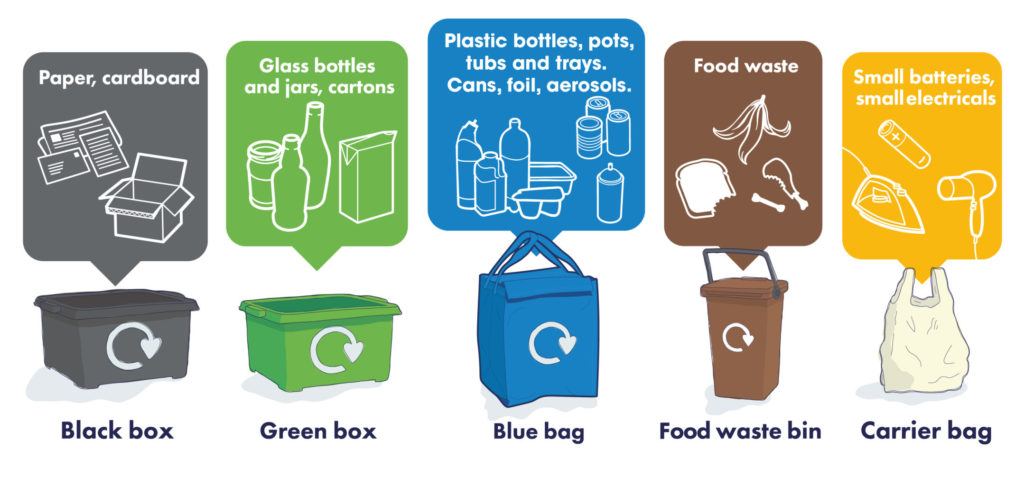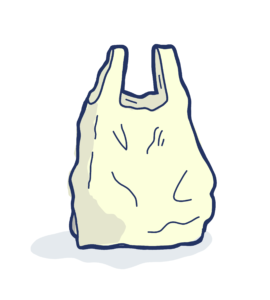Introduction
We will collect your recycling and food waste every week. This might be different for properties with communal (shared) collections.
You can check your collection days online or download a service guide by using the button below.
Our Recycling Tracker shows exactly what happens to every tonne of recycling we collect. Sorting your recycling into the correct containers helps us recycle more material.
What we collect
Bright Blue Bag
- Plastic bottles – Rinse and squash the bottles and put caps and tops back on. Throw away pumps and trigger sprays.
- Plastic pots, tubs and trays – Any colour can be recycled.
- Tins and cans that are steel or aluminium – Rinse cans, and squash them if it is safe to do so. Place any loose lids inside the squashed cans. There is no need to remove labels.
- Aluminium foil – Make sure it is rinsed and scrunched.
- Aerosols – Must be empty. Do not pierce them. Please note: gas canisters are not accepted.
- Toothpaste tubes – Must be empty.
![]()
Box 1 (usually black)
- Paper – Newspapers, magazines, leaflets, directories, white envelopes (no need to remove windows) and white paper.
- Cardboard – Brown or grey, corrugated, greeting cards or brown envelopes, Pringles brand tubes (non-metal base version). Small pieces can go inside larger boxes, cut or tear up the large pieces.
- Large boxes – Pieces should be torn up or taken to a recycling site.
![]()
Box 2 (usually green)
- Glass bottles and jars – Rinsed bottles and jars are accepted. Put metal and plastic tops and lids back on. Please note: Broken glass is not accepted. Table or cookware is not accepted.
- Cartons, such as Tetra Paks – Please rinse, squash and put any caps back on.
![]()
Food waste bin
For all food waste, cooked or raw.
![]()
Plastic bags
- Small household batteries – Put in a tied plastic bag.
- Small household electrical items – No bigger than a carrier bag (such as kettles or toasters). Put in an untied plastic bag. TVs, monitors and microwaves cannot be collected.
- Textiles – Only clothes of good enough quality to be worn again (that you would take to a charity shop). Put in a tied bag (to keep dry) and put on top of a recycling box.
Textiles like bedding, curtains, blankets and throws are not collected at the kerbside (good quality clothes, shoes and textiles can be taken to recycling sites).
What we do not collect
These items are never taken in a kerbside recycling collection.
- Compostable or biodegradable packaging – These cannot be recycled with our food or garden waste collections.
- Broken glass or light bulbs (broken or unbroken) – Unbroken low-energy light bulbs can be taken to any recycling site.
- Glass that is not a bottle or jar, such as mirrors, drinking glasses, vases or Pyrex.
- Old or unused wallpaper.
- Shiny or thermal paper – As used for many till receipts.
- Plastic films and wrappers – For example crisp packets, pet food pouches, film lids or bread bags. Many supermarkets now collect soft plastics.
- Syringes, knives and other sharp objects.
- Metal kitchenware, such as saucepans, baking trays or cutlery.
- 5 litre large beer kegs.
- Old metal tools.
- Nappies and pet excrement.
- Large quantities of cardboard or very large boxes – Please take them to a recycling centre.
- Single-use “paper” cups – Find a local collection point using the National Cup Recycling Scheme.
- Textiles other than wearable clothes or shoes – Please take to a charity shop or textile bank.
- Blister packs, such as those used for pills.
- Gas canisters, the high pressure of the gas is stored in the bottle makes it more likely to explode when crushed.
- Microwaves, TVs or computer monitors
How to put your collection containers out
Unless you have an assisted collection, containers should be at the edge of your property by 7am on collection day and no earlier than the night before. Please take care not to obstruct pavements or roads, and take containers back in as soon as possible after collection.
Only use carrier bags for wearable clothes and shoes, shredded paper, small electrical items or batteries.
Never use black sacks for recycling, as they will be mistaken for rubbish.
We do not supply lids for recycling boxes. To assist with storage between collections, you can buy stretch covers for boxes.
Security and identity theft
Destroying or shredding confidential or sensitive materials is an essential precaution before putting them in a recycling box.
Much of the concern about identity theft has now moved to the risks of online cybercrime. Before this, police have warned about suspicious individuals spotted looking through recycling boxes at night.
The police and government advise that householders should take steps to avoid fraud or identity theft. Credit cards and similar items must be fully cut up, while documents that could be misused should be destroyed, preferably by shredder.
These can include bank statements, credit card receipts, utility and tax bills, pay slips, old driving licences or passports, as well as items with signatures or National Insurance numbers.
Even material that seems safe, such as received mail with your name and address, can be misused when combined with other forms of identification.
Shredded paper can be left out in a tied carrier bag,
If large amounts of paper need destroying, residents may wish to use our business directory and other sources to find companies offering confidential waste services.
More on identity theft risks can be found on the National Fraud and Cybercrime Reporting Centre website.



